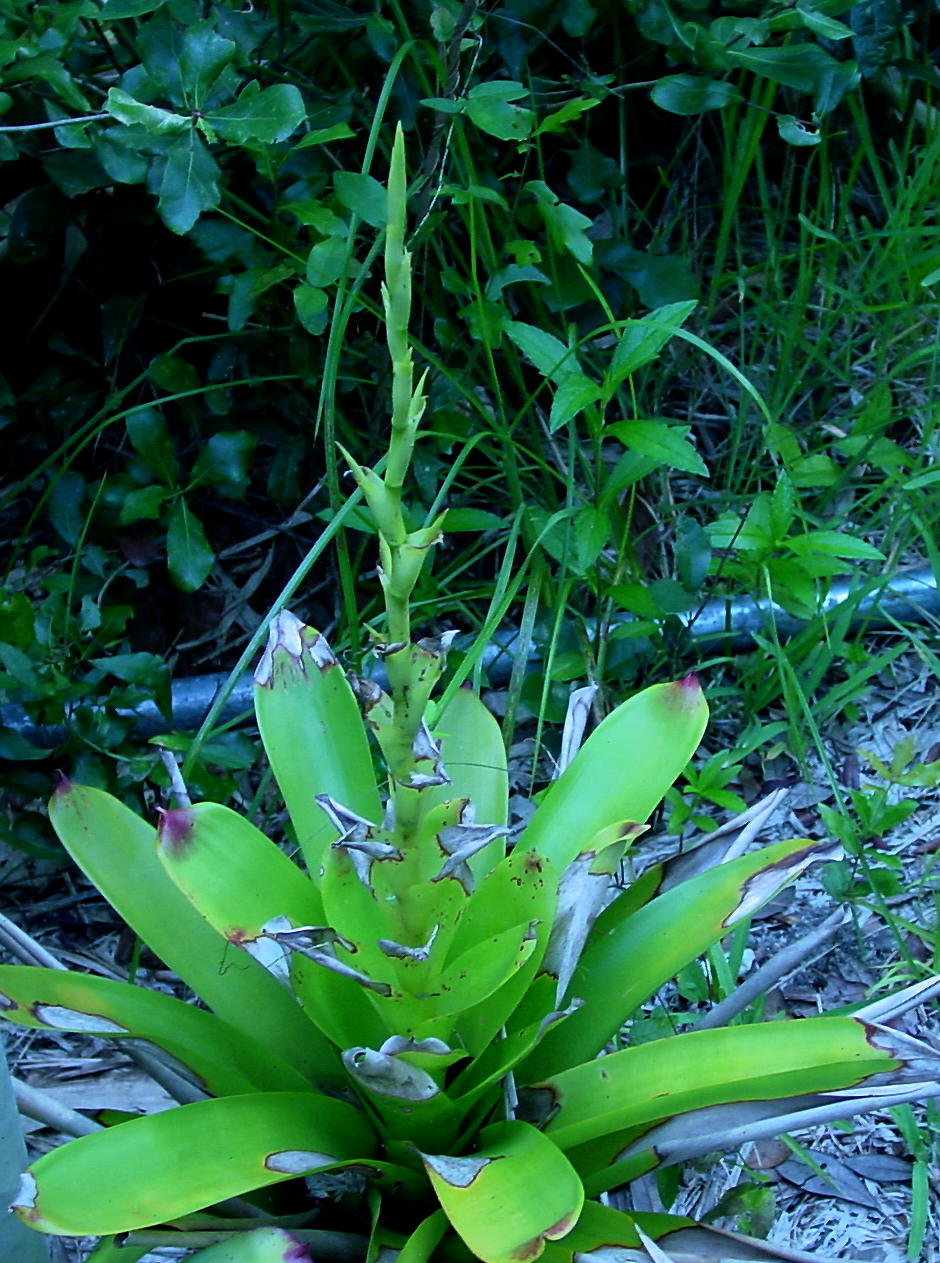
|
The Florida East Coast Bromeliad Society Next meeting Sunday, August 9th – 1:30p.m. Wm. A. Finney Memorial Garden Center 837 N. Oleander Ave., Daytona Beach |
Back to School!
President – Joan Campbell – 672-7382
Vice President – Jerry O’Keefe – 407/767-2442
Secretary – Calandra Thurrott – 761-4804
Treasurer – Eve Krauth – 763-2084
________________________________________________________________________________
It seems like the Summer has just begun…
and here we are with school about to resume already! Time has a way of sneaking by without us realizing it and for those of us who tend to procrastinate, this can be a serious problem. Summer is not the time to rest on our laurels (or whatever else it is that you rest on). We need to tend our bromeliads closely and make the most of these warm, sunny, and humid days. Pups on Neos. seem to be getting larger now on almost a daily basis. Don’t let them get so large that the parent plant begins to affect the symmetry of the pups. If they are large enough to remove, do it now and take advantage of our current near-perfect growing conditions! Don’t wait for cooler weather in the Fall or they’ll begin entering their near dormant period. Have you noticed a bit of scale on some of your plants? Take care of it now! It will only get worse and damage to the leaves will not repair itself. Does it seem like some of your plants are sitting in a wet, squishy potting mix? Replace that mix now! Your plants may tolerate this in their rapid growth phase, but give them another month or two and continually wet feet can be fatal!
I know, this sounds like I’m suggesting that you go outside and work in the yard during some of the hottest months of the year…and I guess that is what I’m saying. There is a right way and a wrong way to go about this however. Yes, the temperature can be pretty high in the afternoon – that just means that you need to get up early (that’s not as bad as it sounds) get outside and get your work done and then spend the rest of the day in air conditioned comfort watching old movies and eating bon-bons. When the afternoon thunderstorms roll past and your chance of getting struck by lightning is a little less, go back outside and get some more work done before it’s time for dinner. You’ll be surprised at how much the temperature drops off after a good thundershower. So, what are we saying here? In the Summer, don’t work harder – work smarter. Work a little when the weather conditions are tolerable, avoid the heat of the day, and then take another crack at it later in the day when the temperatures are cooler.
This month’s meeting –
Our Vice President has managed to talk Dean Fairchild into visiting us for this month’s meeting and no, it is not a coincindence that the last name is spelled the same as that of Fairchild Gardens in South Florida. Dean moved from the Miami area to Apopka in Central Florida a few years ago and now is very active in the Central Florida Bromeliad Society. He is the co-author with Derek Butcher (former BSI cultivar registrar) of "Bromeliad Key for Dummies" (that’s my kind of publication!), a master bromeliad show judge, a collector, a grower and well-known bromeliad hybridizer and has been honored by having his name attached to more than a few bromeliad cultivars. Dean is just a wealth of information about bromeliads and he has agreed to share some of that knowledge with us this month. You won’t want to miss this program!
The Bus Trip…
has progressed from a good idea of Jerry’s to a definite field trip to Tropiflora in Sarasota on Saturday, September 12th. If you haven’t signed up already, time is running out. See Jerry at this month’s meeting and be prepared to give him your $35 for the one day excursion or you will be left out. This price includes transportation to and from Tropiflora (we wouldn’t just leave you there now would we?) plus a barbecue luncheon at the nursery. I don’t know how he managed to get this great price, but I can state with some confidence that I can’t drive to Sarasota and back for that low a cost (and I get pretty good gas mileage). Looking for a day’s entertainment? Admission to the mouse house (a.k.a. Disneyworld) alone would be far above $35/head. This is a great deal and a great opportunity to visit one of the world’s premiere bromeliad nurseries. Who knows? You might even find a bromeliad or two…or three…or more that you will want to purchase and bring home with you.
Obituary
We recently received the sad news that former FECBS member Skip Garrison has passed away. Skip had been a merchant on Main St. in Daytona Beach and was an avid orchid grower for many years before getting the "bromeliad bug." He attended meetings only on rare occcasions, but kept in touch and showed his support with frequent donations to the club of plants, cypress pieces for mounting epiphytes, and more recently books from his collection. Last year he donated an extensive collection of gardening books to the Halifax Council of Garden Clubs as well as a copy of the Baensch bromeliad book to FECBS for which we are extremely grateful. Skip was a good friend and a perfect example of how everyone has their own ways of supporting organizations.
"All bromeliads bloom…"
How may times have you heard that said by speakers who are deemed to be authorities in bromeliad culture? And how many of you have at least one bromeliad in your collection that apparently missed the lecture on blooming and now stubbornly refuses to put up a bloom spike? Probably the most common complaint that I hear from new growers is that they have had great luck in growing pups of a particular bromeliad after purchasing it in a home and garden center, and now have many plants that seem to be full grown but refuse to bloom. Aechmea fasciata is often the subject of this discussion – a common, commercially available variety that sometimes can be a bit stubborn. Usually I ask whether they are fertilizing it. If their answer is "no" then my response is "that’s your problem!" and if they say that they fertilize it regularly I say "stop fertilizing it" (see how this works?). Then I ask if it is growing in strong light (response – "put it in the shade"), if they are growing it in low light ("put it in stronger light"), and so on. The basic point I try to make is that if current culture practices are resulting in the plant not blooming, you should try something different. And often that’s all it takes to spur the plant into bloom – a change from it’s normal routine. The grower ends up with a beautiful blooming bromeliad and I look like a genius – everybody wins! Unfortunately, it doesn’t always work out that way. Occasionally you have that "hard-core" non-bloomer that simply refuses to cooperate. I think everyone runs across these plants at some point – whether it be that unusual Hohenbergia, or a seldom seen species of Aechmea, or, in my case - Vriesea phillipo-coburgii. I acquired this plant quite a long time ago at an Extravaganza and was advised by none other than Wally Berg (certainly an authority on bromeliad culture and someone that you paid attention to when he gave advice) that "you may have a little trouble getting that plant to bloom!" That turned out to be an understatement. Over the next decade I put my plant and its progeny (this plant is very generous in producing pups) in full sun (it seemed to like this just fine, but didn’t bloom), full shade (it liked this too and turned a little greener, but didn’t bloom). I let it form a large clump (sometimes bromeliads like a little company before they bloom) with no response. I split it into individual plants and potted them in multiple varieties of potting mixes (it continued to grow and reproduce just fine, but didn’t bloom). I left it out in the cold (Wally also said it may need some cold weather to spur it into blooming) when temperatures fell into the 20s. It didn’t seem to mind this either…but it didn’t bloom. I even used Herb Plever’s ethylene pills and followed his instruction precisely – the Aechmeas that I treated at the same time bloomed, but not Vriesea p-c. Finally, this past Winter we had a spell of really cold weather and I left one potted specimen of phillipo-coburgii outside to fend for itself, but took pity on a larger clump of the same plant and carefully covered it with frost cloth until the weather warmed a bit. In mid-June I noticed a tell-tale elongation of the center of several of the plants in the clump and by early July it was clear that these plant were putting up an inflorescence…and so was the plant that was left out in the cold! Below-beginning of bloom

The only obvious difference was that the plant that wasn’t covered had severe leaf damage while the clump that was covered appeared unscathed.

V. phillipo-coburgii showing leaf damage from cold
Interesting, but the story doesn’t end there. In mid-July I had occasion to visit the Boca Raton Bromeliad and Tropical Plant society in South Florida (an interesting, rowdy bunch) and during the course of their meeting, the president asked if anyone was growing Vriesea phillipo-coburgii. Mine was the only hand raised, and he proceeded to inform the group that he had been growing this plant for well over 10 years and had come to call it "the plant that never blooms". He was amazed to notice that his clump of Vriesea p-c was putting up several bloom spikes! Finally, last weekend a grower in Deltona told me that for the first time in memory, his Vriesea p-c also was blooming. What triggered the same species of bromeliads (plants that hadn’t bloomed for several generations) in Port Orange, Boynton, and Deltona – three widely different climates – to all begin blooming at the same time? I’m doubting that the deciding factor was cold weather alone. Cold weather in South Florida is probably 20 degrees warmer than in Port Orange and Deltona tends to see low temperatures somewhere in between the two. Could it be the combination of cool weather last Winter followed by an unusually wet Spring and Summer? Typically we see little or no rain in the Spring for three to four months, but this year we experienced frequent rains culminating in enough rain in one event in May that caused wide-spread flooding for several days. These rain storms soaked much of the east coast of Florida during this period and that is the only obvious connection that I see linking the three different locations.
So, the comment that "all bromeliads bloom" is once again proven correct. Sometimes however, you may have to wait for over a decade to see that bloom…and you may never know for certain what caused that bloom to be triggered.

Clump of V. phillipo-coburgii coming into bloom for first time in a decade!
Upcoming Events:
August 14th - 15th, 2009
(17-92 and Lake Mary Blvd.- turn right at this intersection and in about 1000 ft., turn left onto Fairmont)
200 Fairmont Drive, Sanford
September 12th, 2009
Bus trip to Tropiflora
September 19th, 2009
Judges school begins in Ft. Meyers.
Interested? Contact any of your club officers for more information.
November 13th – 15th , 2009
Bromeliad Extravaganza, hosted by the Central Fl. Bromeliad Society at the Orlando Renaissance Hotel (544 Forbes Place, Orlando 32812.
November 21st - 22nd, 2009
December 4th - 6th, 2009
